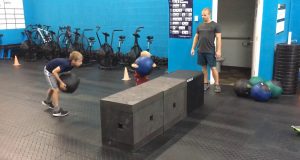There has been a lot of research over the past 10-15 years that has shown that our bodies are just amazing adapters. So, if you have been working out for awhile and do the same routine all the time, particularly if you’re going to a gym and you start on a certain machine and you go through in the same exact order every time, your body has probably gained 90% of the results and improvement that it can by doing it that way. Our bodies adapt specifically to what we are doing, so if you are weight training, you need to be switching up your routine all the time. You need to change your angles, you need to change the direction in which you are doing it. There are all kinds of ways to keep your body guessing, but it’s important that you keep your body guessing and not get into a set routine that you never change.
It has been shown that if, say, marathon runners, whom we all consider to be extremely fit individuals, were put in a pool and told to swim laps, in 2-4 laps they would be winded, which is hard to imagine. However, given that their bodies are specifically trained for running, swimming is foreign to the body, and their bodies are not trained to do that. It is very important that if you’re going to choose certain things to train for, that you think about switching around a little bit, so that your body gets variety and continues to progress and grow. It will be what is called “cross-trained.” It will be specifically trained for many different types of things.
If you want to be an excellent hiker, of course you need to do hiking, but it would be also very much a good idea to cycle some and to do some stair climbing and to do some weight training and maybe do some swimming. Mixing it up is one of the best things you can do to stimulate constant and consistent progress. Our bodies have no ceiling, there is no limit to how strong we can get, how fit we can get. It’s just a matter of keeping things fresh. Change them every chance you get.
Now, how often you change your routine? I would say no less than once a month. I personally change the routines on my clients and myself every time we workout. Some people work out with me once a week, some people work out with me 3 times a week, and the routine is different all the time. I’m a real advocate of keeping it interesting, keeping it fresh and keeping your body guessing.
Some of the ways that you can change your routine to keep it interesting and keep your body progressing is to do different types of workouts when you’re training. There are many types of workouts, and what I mean by that is different ways to do the same thing, but differently.
Circuit training is a wonderful way to throw your body a little curve. What you would do is warm up for 6-9 minutes on any piece of cardio equipment. If you have many pieces at your disposal, such as in a gym, you will want to change them around every time you come back to cardio. Circuit training is intervals; you can set any interval you want. One that I like particularly is that after you’ve warmed up, you would do 1½ minutes of weight training, then you would do biceps curls for 1½ minutes, then you would come back to the cardio equipment and do another 3 minutes. You would continue like that over the course of an hour. So, each time you go to weight train for 1½ minutes, you are going to change muscle groups. The next time you go back to weight train, you would do, say, triceps. Then you would go back and do 3 minutes more of cardio. You want to alternate back and forth like that, and be sure to change muscle groups all the time, so that you will end up with a full body workup and probably at least 30 minutes of cardio. This is an excellent way and efficient way to train your body. You’re killing 2 birds with 1 stone. You are both fat burning, using your aerobic system, and you’re training your body muscularly, using your anaerobic system. This is just a great program.
Also, you can do what I would call negative workouts, positive workouts, pyramids, reverse pyramids, slows or ultra-slows. I will go into detail on each one of these in terms of your weight training routines. These are ways to mix it up for your weight training routines.
The negative workout is basically going slowly through the most difficult part of the move, so if you were to take biceps curls, when you’re coming up is considered the positive side of the movements. You would come up in 1-2 counts, then you would lower it slowly for anywhere from 5-10 counts. That is the negative side of the movement, and when you are fighting gravity the most. This is a really effective way to break plateaus. You can switch that around, however, and do what we call a positive workout. You can go slowly on the upward part of the movement, with a normal 1-2 count release. That is considered a positive workout, and you would do that with all the different muscle groups of your body.
Pyramids are basically 3-set pyramids or 5-set pyramids, whatever you have time for. Typically I do 3-set pyramids, because they are the most time efficient. A pyramid is setting your first weight at a weight you have done before successfully with, say, 8-12 reps. Then, on your second set, you’re going to go up 20%. It may very well be a weight you’ve never done before. You’re going to do as many repetitions are you can. It is unlikely you’ll get a full set, but you may, depending on if you were ready for an increase here or not. Then, on your third set, you go back to the weight you were using the first time, or maybe a 10% increase. That would be a pyramid.
A reverse pyramid would be to start heavy, a weight you’ve never done before. Then, you go to a weight you have done on the second set. Then, on the third set, you go back to a weight you’ve never done before, a heavy weight. You’re going to failure on all of these. You want to do enough repetitions that you can’t do another one without breaking form, without losing the really fine form that you should be keeping, and that’s your stopping point.
When you do ultra-slows or slows, you are using whatever exercise you are doing, say a biceps curl. As you come up into your contraction, you’re going to count to 5, then you will release in 5 counts as well. That’s considered a slow. Then, you can do an ultra-slow, where you’re coming up in 10-15 counts and going down in 10-15 counts.
These are all ways to just mix it up, keep it different, keep your body guessing and very, very important to do if you want to keep your progress consistent and your body growing more and more strong all the time.
[ad_2] Crossfit Blogger News, Information and Bestselling Products
Crossfit Blogger News, Information and Bestselling Products




